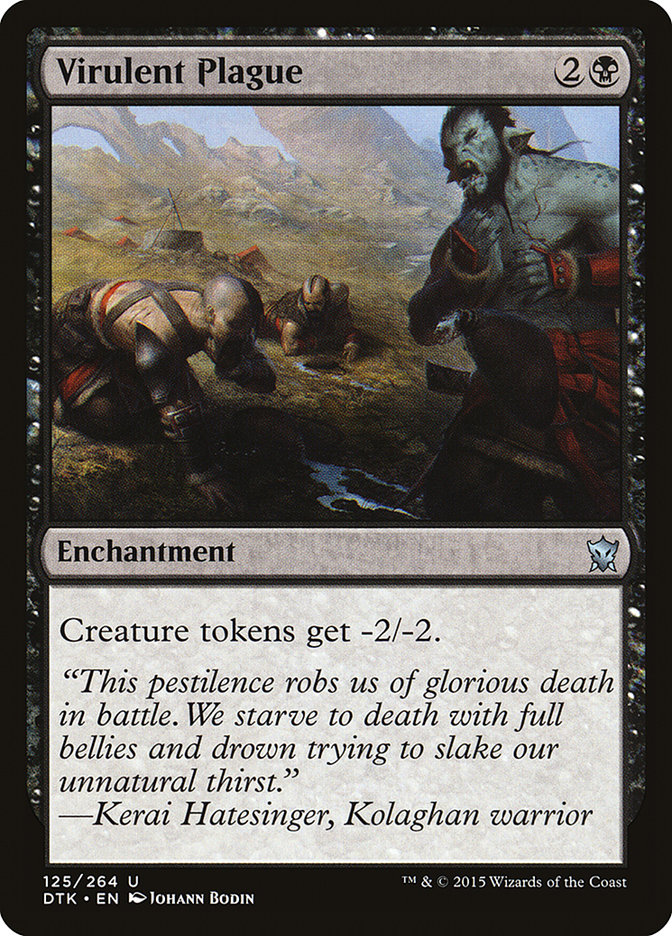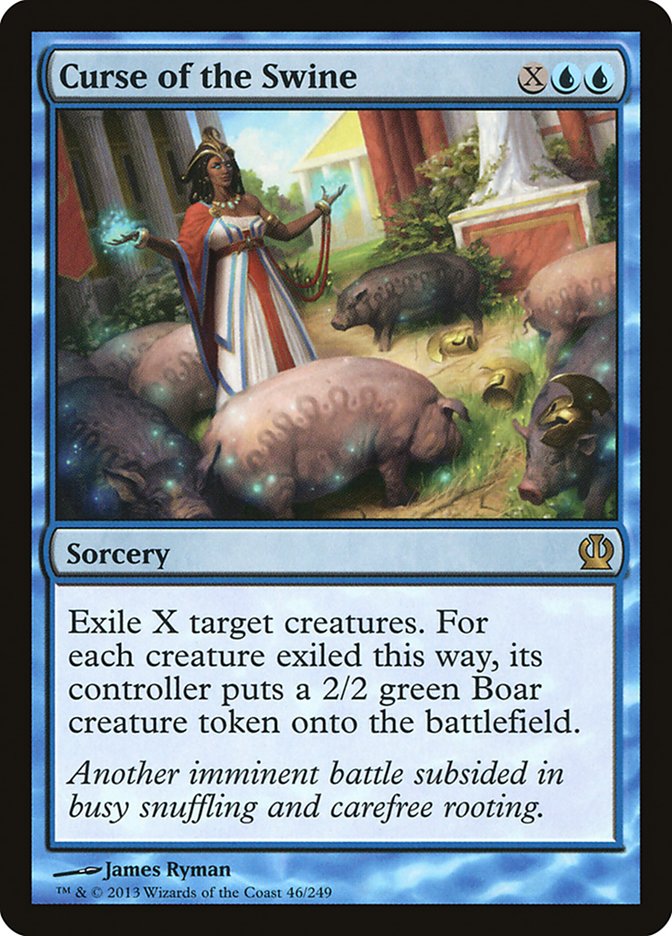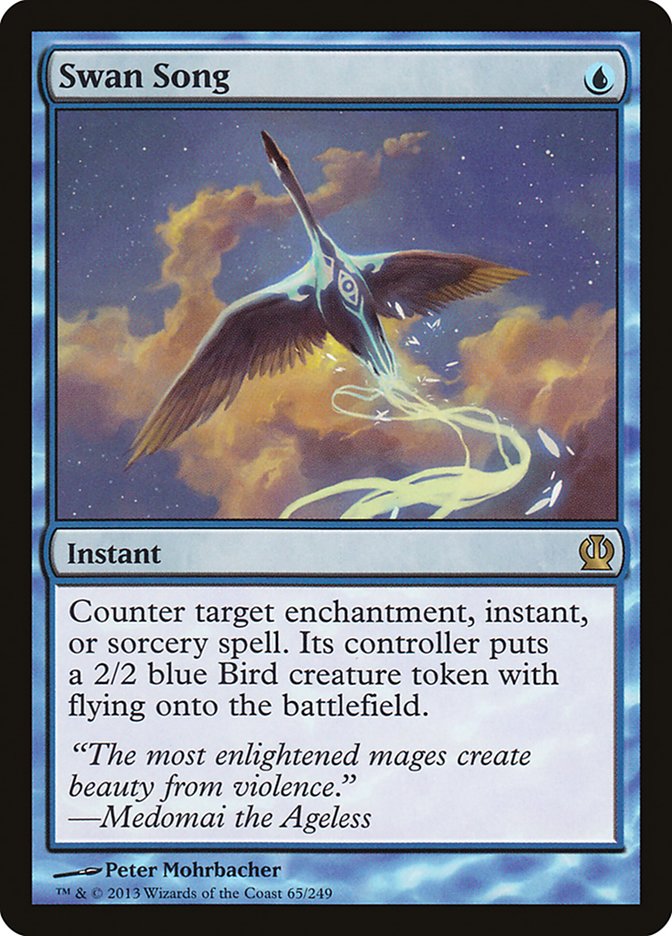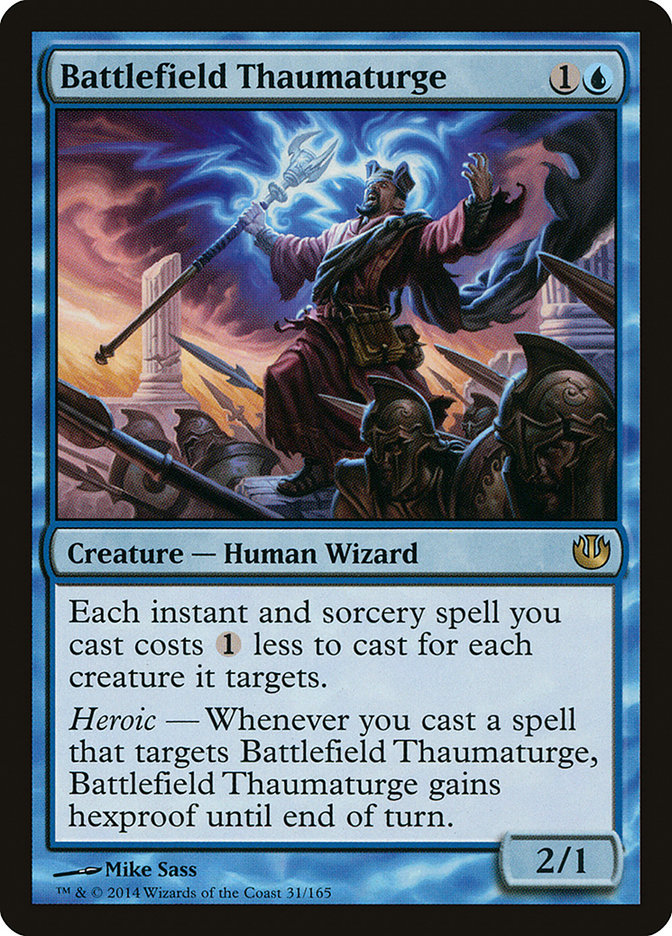Ever see a card that’s so perfect for this one deck you have on your deckbuilding to-do list, but no one else even know it exists? You might have seen the
spoiler, slapped your knee and said, “That’s perfect for my counter-burn deck,” or “That’ll go great in my Mono-Green Control list,” or even “I can’t
believe they printed the perfect piece in my Jeskai Infiltrator infinite combo deck.” Even the existing parts of a potential synergy are often lost on
those who stick to prescribed decklists, but sometimes you, or rather Wizards, just nails it.
In this case, this new Dragons of Tarkir card was one I was sick of waiting for.
This is a pretty serious token hoser. Created in the lineage of Illness in the Ranks, Virulent Plague undermines most token producers in Standard, and a
pair of them handle the rest. This is particularly good timing, as token-based strategies of all kinds are dominating Standard: Jeskai Tokens, Mono-Red,
green-based Nykthos, and even control decks that rely on Elspeth, Sun’s Champion to do their lategame dirty work, use tokens as a critical component of the
deck. Having a permanent answer for the vast majority of Standard tokens is powerful in and of itself and could see sideboard or even maindeck play
depending on the metagame in which you find yourself.
But even if your opponent doesn’t use a token strategy, you can make them play one thanks to two critical cards.
Together, these spells have been dismissed as sacrificing too much to justify play; the Curse doesn’t help win if you’re behind or your opponent’s
creatures are small and feature few other stats, and Swan Song provides an evasive flyer for being a slightly cheaper, more limited Negate. However, with
Virulent Plague, that bothersome token becomes irrelevant. It doesn’t require an extra reactive card, it just removes the disadvantage completely,
letting you cast either one with impunity.
Among a myriad of other potential combinations in Standard, Battlefield Thaumaturge lends enormous power to Curse of the Swine, allowing you to cast it for
two mana and exiling as many creatures as you can target.
Two colors, cheap spells, high potential – sounds spicy! Admittedly, I have done this before, namely when both spells were first and while Illness in the
Ranks was still Standard legal.
Creatures (14)
Planeswalkers (2)
Lands (24)
Spells (20)
- 3 Ratchet Bomb
- 4 Rapid Hybridization
- 4 Illness in the Ranks
- 2 Bident of Thassa
- 4 Curse of the Swine
- 3 Swan Song
Sideboard

While fun, it took a while to get some additional tools to improve the deck, and I worked on it behind the scenes as we got additional creatures and spells
to facilitate the concept. After Khans of Tarkir came out and Return to Ravnica (and the accompanying Gatecrash enchantment) faded into Modern, I shelved
the deck indefinitely.
Now, however, the deck has new life, and it’s grown up since we last saw it! No longer did I have to have two copies of an enchantment to make it work; one
would do, and the format was ripe with token producers already! Between enchantment-matters and the strong color support, a new version of the deck was
right around the corner.
Creatures (16)
Lands (20)
Spells (24)

Building off a recent U/B Ensoul Artifact shell, I struck out to
capitalize on the new Virulent Plague. I liked a lot of things about this particular decklist; Pain Seer would help draw you into the “combo,” while
Disciple of Deceit could help smooth out draws by tossing excess copies of Swan Song or Curse of the Swine when I didn’t have Virulent Plague yet.
Anticipate, a card I hadn’t tried out much, was also another combo accelerator.
This is where it started but the numbers seemed wrong, and the power level (especially if you missed drawing Ensoul) was pretty low. It also lacked a
stable win condition outside of Ensoul Artifact and, thanks to a couple unbalanced changes, I left myself without other three-drops to toss to fetch the
deck’s critical enchantment. A lot of things needed to change even before I started testing, but the first thing I did was throw the artifact theme out.
Creatures (27)
- 4 Mogis's Marauder
- 4 Pain Seer
- 2 Battlefield Thaumaturge
- 4 Disciple of Deceit
- 4 Ruthless Ripper
- 4 Bloodsoaked Champion
- 4 Mardu Shadowspear
- 1 Tasigur, the Golden Fang
Lands (22)
Spells (11)
Sideboard

After freeing up lots of space and balancing the dream combo with reliable win conditions, I landed here. Now, I’ll admit, the Mono-Black Human decks that
have seen both local and international success at Pro Tours have a lot in common with this deck, so I’m not afraid to admit the similarity in creature
options, but a lot of the similarities end after this surface-level realization occurs.
Creatures
While many of the creatures could find their home in the current Mono-Black Humans shells, these particular critters were chosen with a specific plan in
mind. Mardu Shadowspear, a relic from the U/B Ensoul deck, proved to be a handy tool to provide lategame reach and flexibility while also being an
excellent turn 1 play. Bloodsoaked Champion is the deck’s workhorse. Besides being a fast and able attacker, it’s also an amazing discard for Disciple of
Deceit. Tossing this during your untap step won’t lose you much of anything as you go find a Swan Song or Mardu Shadowspear to dash and rebuy it
postcombat. Ruthless Ripper is a Mono-Black Humans staple, and it provides an identical function here. Bear in mind that, if morphed, you can respond to
Disciple of Deceit’s untap trigger to reveal your black card and flip it before pitching it and finding something else.
The deck’s two-drops are at once familiar and new. Pain Seer had speculation surrounding it from the moment it was spoiled last January. It’s finally found
a home in this and like-minded decks. Disciple of Deceit is a bit of innovation for the Mono-Black list, as it gives card advantage and consistency without
greatly disrupting the manabase or tribal plan. Battlefield Thaumaturge is a human, too, and it can be tutored with the Disciple when you’ve got the
Virulent Plague out and Curse of the Swine in the wings. Finally, Tasigur, the Golden Fang provides a bit of single-handed pushing without disrupting the
theme. All the one-drops can help fuel an early Tasigur.
Spells
The spell list is brief and tailored to the deck’s strategy. Obelisk of Urd seemed to be a necessity after I’d watched enough games of Mono-Black Humans,
and it provided another way to activate my two inspired creatures. Anticipate would help reduce the variance and is a fine tutor target for a two-mana
spell when I’m not totally sure what I need. Swan Song and Curse of the Swine, originally much more prominent, have been reduced to simple tools in a
toolbox thanks to the reliable tutor of Disciple of Deceit and the fact that, well, you only ever need one Curse of the Swine to finish a game.
Even Virulent Plague got held back, with two copies sufficient to keep the token armies reliably at bay.
Land
The manabase was awkward considering I’d have hands where double-blue or double-black might be needed one turn after the other. Moreover, I needed to be
fast; with no Underground River in sight, I had to keep Dismal Backwater to a minimum and uncolored mana out of the deck entirely.
Sideboard
Bile Blight plays second fiddle to dealing with an army of boars and birds, but it seems broad enough to warrant a full set to ward off early attackers on
the draw or play. Silumgar Sorcerer, one of the more exciting uncommons from Dragons of Tarkir, subs in as a flying human against midrange decks that rely
on Siege Rhino, Courser of Kruphix, or Thunderbreak Regent to stay on top. Dark Betrayal is a narrow but powerful removal spell in the mirror or against
any other number of aggressive and midrange matchups, all without being a big drain when turned face up with Pain Seer. Encase in Ice was admittedly an
experimental inclusion, but it seems like the perfect blue answer to a nasty problem. Between that and a Virulent Plague, you can shut any Goblin
Rabblemaster down instantly. Daring Thief, as a Human within the mana cost range and a potentially powerful inspired trigger, offers additional options.
Trading away a Virulent Plague is irrelevant, so you can get some classy stuff in exchange. Two extra copies of Swan Song and an extra Virulent Plague give
me a stronger game against slower, control-oriented lists.
I jammed this with some friends locally to test the waters and see how the plan worked.
It was…fine. The deck performed its best when I had early inspired creatures to build a big strong hand and overwhelm the board with small creatures just
in time to stick an Obelisk of Urd. Bloodsoaked Champion was excellent, and Mogis’s Marauder was critical for forcing through damage; I don’t know if you
know this, but getting 2/1s and 2/2s in against most decks these days is a bit of a challenge. Swan Song also proved to be a very powerful card, with or
without the Virulent Plague to shoot the Bird token down.
Regardless of the deck I was fighting against, my chances of winning decreased quickly with each turn the games continued. On-time Obelisk of Urd pretty
much spelled game over, but there were lots of times where untapped inspired creatures were all I could manage, and so I’d just be in topdeck mode until I
drew an Obelisk or a Mogis’s Marauder. Battlefield Thaumaturge and Tasigur proved to be pretty bad in this deck, as Tasigur was often just a big bruiser
that came out a turn early, and the Thaumaturge had literally no beneficiaries of its ability except Curse of the Swine. Anticipate was also
lackluster, as most times I’d just prefer a threat that I didn’t have to pay extra for, and I bricked on three lands more than once.
Sideboarding also proved a couple points, most surprising of which was that Bile Blight, in the presence of Virulent Plague, is actually pretty redundant,
not to mention hard to cast thanks to the deck’s four Islands. Silumgar Sorcerer was fine but never outstanding. I never cast Dark Betrayal or Encase in
Ice, and Daring Thief never came in.
I fought Esper Control (won), Mono-Red (split), Green Devotion, and G/B Constellation (lost both after long matches in game 3). This is not any kind of
record I’m excited about, but I wasn’t about to give up. The deck was really exciting to play despite its somewhat linear profile, so I dug in again, this
time gutting the majority of the original combo and adding consistency and toolbox cards.
Creatures (27)
- 4 Mogis's Marauder
- 4 Pain Seer
- 4 Disciple of Deceit
- 4 Ruthless Ripper
- 4 Bloodsoaked Champion
- 1 Marang River Prowler
- 4 Mardu Shadowspear
- 2 Silumgar Sorcerer
Lands (20)
Spells (13)

Voila! Out with the Curse of the Swine for the far superior Swan Song. Triton Tactics, a card I’d considered to activate inspired instantly and make
combats more painless, was actually nuts in here despite the lack of heroic targets. Ultimate Price, while easier on the mana, actually did what
the deck needed. Most previous matches, I found I almost always wanted a Murderous Cut, so this felt like a compromise that was tutorable and
easier on Pain Seer. Springleaf Drum came in for two Islands, pushing me to a precarious twenty lands. The way I see it, though, is that the Islands were
never good turn 1 lands (nothing to play but Swan Song), so replacing them with something that allowed me to fix and tap an inspired creature at will was a
good exchange.
The sideboard now includes a full set of Ashiok. Against decks where you’re filling the ground with cheap, aggressive threats, opponents will often side
into Anger of the Gods, Drown in Sorrow, or Bile Blights of their own, taking out Hero’s Downfall and any other single spot removal. Ashiok can build
loyalty fast. It won’t be long after before the planeswalker will have to be the primary combat target. I also wanted to try Marang River Prowler as a
maindeck and sideboard card, giving the deck longevity and a serious recurring punch. The inability to block is important, and duly noted.
This one, in brief testing against a Temur Aggro list and B/R Dragons list, was pretty good; I could often get underneath the deck’s bigger creatures like
Savage Knuckleblade and Stormbreath Dragon, while removal was often too slow or poorly aimed to slow me down. This felt a whole lot better, and the
singletons from the sideboard shined beautifully.
While Virulent Plague didn’t prove it was the glue that held the original archetype together, it is still an important sideboard card in today’s metagame,
and you can leverage its power a bit with undercosted blue spells like Swan Song. Its impact is subtler, though, giving black an alternative that keeps it
less reliant on Crux of Fate and Bile Blight to control multiple creatures on the board. The power level is good, but it takes some practice to utilize it
effectively.
With Illness in the Ranks reaching some Modern sideboards, do you think this newer, bigger iteration has any future? Has it found a home in your sideboard,
and how has it saved you in matches you’ve played?





